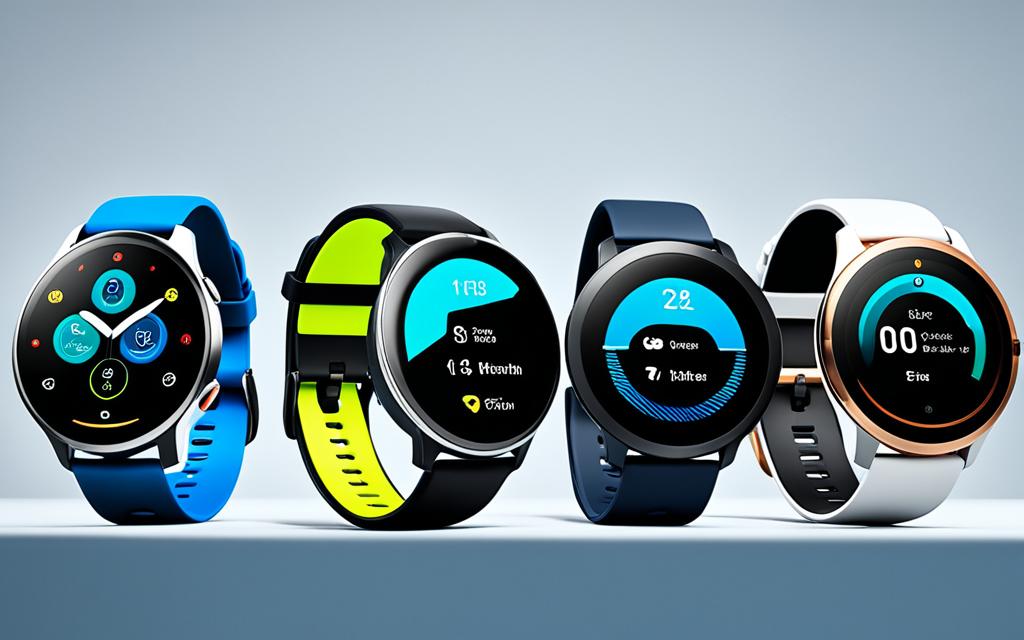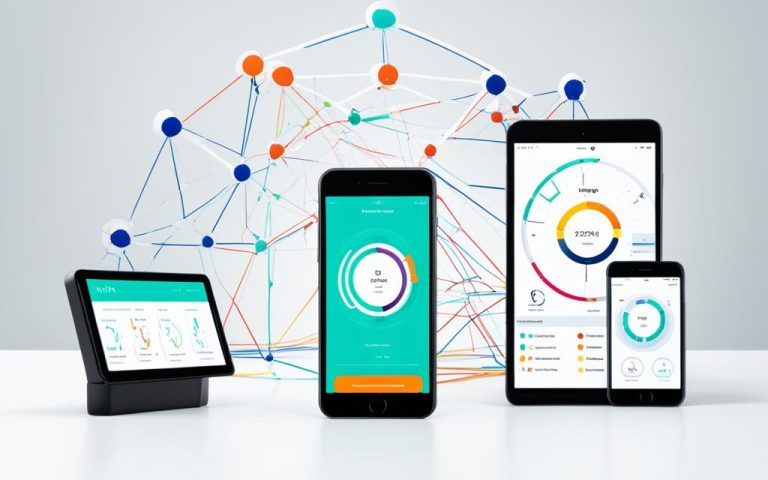Smart clothing is revolutionizing the way we interact with technology and enhancing our connectivity in unprecedented ways. These garments integrate smart wearables, allowing for intelligent services and personal connectivity within personal area networks (PANs). With advancements in wearable technology and the integration of smart textiles and computing technology, the potential for smart clothing is vast.
Imagine garments that seamlessly connect with objects in the environment and remote servers, enabling advanced services and enhancing our quality of life. The combination of smart wearables, PANs, and other technologies like 5G communication networks and virtual/augmented reality is taking human-to-human and human-to-machine connectivity to a whole new level.
In this article, we will delve deeper into the basics of IoT smart wearables and garments, explore the different types of smart wearables, and understand the definition and classification of smart clothing. We will also discuss the design principles that underpin these innovative garments and their role in shaping the future of wearable technology.
Join us on this exciting journey as we explore the emergence of smart clothing within personal area networks and uncover the possibilities they hold for personal connectivity in the digital age.
Basics of IoT Smart Wearables and Garments
The history of smart wearables and garments can be traced back to the development of wearable computing in the 1960s. Early pioneers like Edward O. Thorp and Claude Shannon created the first wearable computer, followed by Ivan Sutherland’s experiments with smart glasses and helmets. Steve Mann continued to work on wearable computing projects in the 1970s and 1980s.
In the 1990s, the first academic smart clothing platform, the Wearable motherboard, was developed. It paved the way for the integration of computing technology into garments. Commercial wearable computers like the Mobile Assistant were also introduced during this period.
Over time, prototypes of smart clothing have become more advanced and integrated, thanks to improvements in electronic miniaturization, energy efficiency, and connectivity. This has led to the emergence of IoT smart wearables and smart garments that can seamlessly connect with other devices and enable a wide range of applications.
Advancements in wearable computing technology, such as sensors, processors, and communication modules, have played a significant role in the development of IoT smart wearables. These devices can collect and analyze data, communicate with other devices or networks, and provide useful insights and functionalities to the users.
Take a look at the timeline below to get a better understanding of the key milestones in the evolution of smart wearables and garments:
| Decade | Key Developments |
|---|---|
| 1960s | Development of the first wearable computer by Edward O. Thorp and Claude Shannon |
| Experiments with smart glasses and helmets by Ivan Sutherland | |
| 1970s-1980s | Continued advancements in wearable computing by Steve Mann |
| 1990s | Introduction of the Wearable motherboard, the first academic smart clothing platform |
| Commercialization of wearable computers like the Mobile Assistant |
As you can see, smart wearables and garments have come a long way since their inception. The integration of computing technology and textiles has paved the way for innovative applications in various industries, including healthcare, sports and fitness, safety, and entertainment.
Key Advancements in IoT Smart Wearables:
- Miniaturization of electronic components, making them smaller and more discreet in smart garments
- Improved energy efficiency, allowing wearables to operate for longer durations without frequent recharging
- Advanced connectivity options, such as Bluetooth, Wi-Fi, and cellular networks, enabling seamless communication and data transfer
- Integration of sensors for data collection and interpretation, providing valuable insights and feedback to the users
- Integration of actuators for physical feedback or interaction, enhancing the user experience
- Development of smart fabrics and textiles that can withstand washing and provide comfort and durability
With these advancements, IoT smart wearables and garments have the potential to transform various aspects of our lives, from healthcare monitoring and fitness tracking to personalized entertainment experiences.
Stay tuned for the next section, where we will explore the different types of smart wearables and their unique applications.
Types of Smart Wearables
Smart wearables have revolutionized the world of personal technology, enabling users to seamlessly integrate advanced functionalities into their everyday lives. These wearable devices are embedded into smart clothing, offering a new level of convenience and connectivity. Let’s explore the different types of smart wearables and their unique applications.
1. Accessory Wearables
Accessory wearables are widely popular and include devices like smart watches and fitness trackers. These wearable devices can be easily worn or attached to clothing, providing users with real-time information on their health and fitness activities. With features such as heart rate monitoring, step tracking, and sleep analysis, accessory wearables have become an essential tool for those who prioritize their well-being.
2. Textile Wearables
Textile wearables are a fascinating advancement in the field of smart clothing. These wearables integrate electronics into fabrics, allowing for flexible and adaptable garments. Textile wearables offer a seamless integration of technology and fashion, enhancing the overall user experience. Whether it’s a t-shirt with built-in sensors for activity tracking or a jacket that adjusts its temperature based on the weather conditions, textile wearables offer a new level of comfort and functionality.
3. Patchable Wearables
Patchable wearables are thin and flexible devices that can be attached to the skin, providing users with continuous monitoring and data collection. These devices are commonly used in healthcare applications, helping medical professionals track vital signs and monitor patient health remotely. With advancements in adhesive technology, patchable wearables are becoming more comfortable and unobtrusive, allowing users to wear them discreetly.
4. Implantable Wearables
Implantable wearables represent the cutting edge of wearable technology. These lightweight devices are surgically implanted into the human body and provide a range of advanced functionalities. Implantable wearables have the potential to monitor chronic health conditions, deliver targeted therapies, and even enhance cognitive abilities. While still in the early stages of development, implantable wearables offer exciting possibilities for the future of healthcare.
The table below summarizes the different types of smart wearables and their applications:
| Type of Smart Wearable | Applications |
|---|---|
| Accessory Wearables | Health monitoring, fitness tracking |
| Textile Wearables | Comfortable and adaptable clothing with integrated technology |
| Patchable Wearables | Continuous monitoring, remote healthcare |
| Implantable Wearables | Advanced healthcare monitoring and therapies |

The different types of smart wearables offer a wide range of applications, catering to various industries and user needs. From monitoring health and fitness to enhancing everyday convenience, smart wearables are reshaping the way we interact with technology. As advancements continue to be made in this field, we can expect even more innovative and exciting developments in the future.
Definition of Smart Clothing
Smart clothing represents a revolutionary integration of textiles and computing technology, elevating garments to a whole new level of functionality. These innovative garments combine traditional clothing with integrated circuit systems, enabling them to perform tasks beyond those of ordinary apparel.
The intelligence of smart clothing is achieved through the seamless integration of smart modules with textiles. This integration allows for improved comfort, flexibility, and concealment of electric components, ensuring that smart clothing remains indistinguishable from regular garments.
One significant milestone in the development of smart clothing was the creation of the smart medical shirt by the Georgia Tech Wearable Motherboard in 1996. Since then, the applications of smart clothing have expanded beyond the military, finding their way into diverse industries such as aerospace, medicine, and fitness.
Today, smart clothing is transforming the way we live and interact with technology. It goes beyond merely being a wearable device or accessory, seamlessly integrating computing capabilities into our everyday attire. Whether it’s monitoring health parameters, enhancing performance in sports and fitness, or providing safety features, smart clothing has the potential to revolutionize various aspects of our lives.
Advantages of Smart Clothing
- Enhanced functionality: Smart clothing offers a wide range of functions that go beyond what regular clothing can provide. These functionalities can include monitoring vital signs, providing haptic feedback, or even implementing augmented reality experiences.
- Seamless integration: The integration of computing technology into the fabric of smart clothing ensures a seamless and inconspicuous user experience. Unlike external wearable devices, smart clothing can blend seamlessly into our daily lives without drawing attention.
- Comfort and flexibility: Smart clothing designers prioritize the comfort and flexibility of the garments. The integration of smart modules within textiles allows for natural movements and unrestricted comfort, making smart clothing suitable for all-day wear.
- Improved data collection: Smart clothing’s integration of sensors enables the collection of rich and accurate data, providing valuable insights for various applications such as sports performance analysis, healthcare monitoring, and personalized experiences.
In conclusion, smart clothing represents a convergence of textiles and computing technology, introducing a new era of wearable apparel with enhanced functionality, comfort, and seamless integration. As this technology continues to evolve, the possibilities for smart clothing applications are endless, promising to improve our lives in ways we could have never imagined.
General Classification of Smart Clothing
Smart clothing has made significant strides in various industries, offering innovative solutions that cater to different needs and preferences. Let’s explore the general classification of smart clothing based on their distinct functions and applications:
Sports and Fitness Smart Clothing
Designed specifically for athletes and fitness enthusiasts, sports and fitness smart clothing focuses on tracking fitness metrics and enhancing exercise performance. These garments utilize embedded sensors and advanced technologies to monitor heart rate, calorie burn, distance, and even provide real-time coaching. With sports and fitness smart clothing, athletes can optimize their training routines and achieve their fitness goals more effectively.
Healthcare Smart Clothing
In the field of healthcare, smart clothing plays a vital role in monitoring health conditions and preventing diseases. These garments integrate sensors and monitoring devices to measure vital signs, track medication adherence, and even detect potential health risks. By providing continuous remote monitoring, healthcare smart clothing helps healthcare professionals make informed decisions and ensures early intervention in critical situations.
Safety Protection Smart Clothing
For individuals working in high-risk occupations or vulnerable situations, safety protection smart clothing offers an added layer of safety and protection. These garments come equipped with features such as impact sensors, GPS tracking, and emergency communication systems. Safety protection smart clothing helps enhance personal safety, as it can detect accidents, notify emergency responders, and provide vital information to ensure timely assistance.
Entertainment Smart Clothing
Entertainment smart clothing adds a touch of excitement to leisure activities by integrating technology directly into garments. These garments enable immersive experiences through features like built-in speakers, haptic feedback systems, and interactive lighting. Entertainment smart clothing is designed to enhance virtual reality gaming, music performances, and other entertainment experiences, adding a new layer of engagement and sensory stimulation.
Each type of smart clothing serves a distinct purpose, catering to specific target groups and providing personalized services. By leveraging advancements in technology and materials, smart clothing continues to expand its capabilities, offering innovative solutions in sports, healthcare, safety, and entertainment domains.
Design Principles of Smart Clothing
Designing smart clothing involves the integration of intelligent modules and careful consideration of the carrier design. The intelligent modules play a crucial role in the functionality of smart clothing, while the carrier design ensures comfort, flexibility, and seamless integration of electronic components.
Intelligent Modules
Intelligent modules are the building blocks of smart clothing, enabling advanced functionalities and intelligent services. These modules include:
- Sensor Module: Responsible for data collection and gathering information from the environment.
- Communication Module: Enables data transmission between the garment, external devices, and remote servers.
- Decision-making and Feedback Module: Processes the collected data and provides intelligent feedback and decision-making capabilities.
- Human-Machine Interaction Module: Facilitates user interaction, allowing individuals to control and interact with the garment.
- System Integration Module: Ensures the seamless integration of different components within the smart clothing system.
These intelligent modules work together to create a sophisticated and interconnected smart clothing system, enhancing user experience and providing valuable insights and functionalities.
Carrier Design
The carrier design is a critical aspect of smart clothing, as it determines the overall comfort, flexibility, and integration of electronic components within the garments. The carrier design takes into consideration factors such as:
- Material Selection: Choosing the right materials that offer comfort, durability, and compatibility with electronic components.
- Overall Design: Designing the garment in a way that ensures flexibility, adaptability, and aesthetic appeal.
- Integration of Electronic Components: Seamlessly integrating electronic components within the garment to provide a cohesive and streamlined user experience.
The carrier design aims to create smart clothing that is not only functional but also comfortable and fashionable, allowing individuals to seamlessly incorporate technology into their everyday lives.
To better understand the design principles of smart clothing, refer to the visual representation below:
| Intelligent Modules | Carrier Design |
|---|---|
| Sensor Module | Material Selection |
| Communication Module | Overall Design |
| Decision-making and Feedback Module | Integration of Electronic Components |
| Human-Machine Interaction Module | |
| System Integration Module |
Conclusion
Smart clothing integrated within Personal Area Networks (PANs) is poised to shape the future of wearable technology. This innovative combination of smart wearables, PANs, and other technological advancements holds the potential to revolutionize various industries and enhance people’s quality of life.
As the development of smart clothing continues, it is crucial to consider the design principles, classification, and applications of these garments. Adhering to these principles will ensure maximum benefits and functionality for users. Smart clothing’s integration with PANs plays a pivotal role in advancing personal connectivity and wearable technology.
The promising future of wearable technology also raises the bar for ongoing advancements. With technologies such as 5G communication networks, virtual/augmented reality, and smart textiles, smart clothing will offer even greater human-to-human and human-to-machine connectivity. This seamless integration will enable new levels of convenience, efficiency, and personalized experiences.
In conclusion, the combination of smart clothing, PANs, and other emerging technologies heralds a transformative era for wearable technology. The future holds immense potential for smart clothing in improving health monitoring, enhancing sports performance, ensuring safety, and enriching entertainment experiences. The future is bright for smart clothing, positioning it as a significant force in the ever-evolving landscape of wearable technology.
FAQ
What is smart clothing?
Smart clothing refers to garments that integrate smart wearables, allowing for intelligent services and connectivity.
How can smart clothing revolutionize industries?
Smart clothing has the potential to revolutionize various industries and improve people’s quality of life by enabling advanced services and connectivity between garments, objects in the environment, and remote servers.
What is the history of smart wearables and garments?
The development of smart wearables and garments can be traced back to the 1960s with pioneers like Edward O. Thorp, Claude Shannon, and Ivan Sutherland. Over time, prototypes have become more advanced and integrated thanks to improvements in technology.
What are the different types of smart wearables?
Smart wearables can be classified into different types, including accessory wearables, textile wearables, patchable wearables, and implantable wearables.
What is the definition of smart clothing?
Smart clothing refers to garments that combine traditional clothing with integrated circuit systems, providing functions beyond ordinary clothing.
How is smart clothing classified?
Smart clothing can be classified into various types based on their functions, such as sports and fitness smart clothing, healthcare smart clothing, safety protection smart clothing, and entertainment smart clothing.
What are the design principles of smart clothing?
The design principles of smart clothing involve the integration of intelligent modules, including sensor modules, communication modules, decision-making and feedback modules, human-machine interaction modules, and system integration modules.
What does the future of wearable technology hold?
The integration of smart clothing within personal area networks represents the future of wearable technology, with the potential to transform various industries and improve people’s quality of life.



















